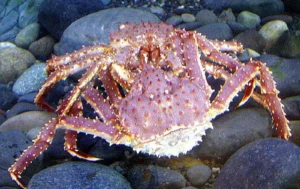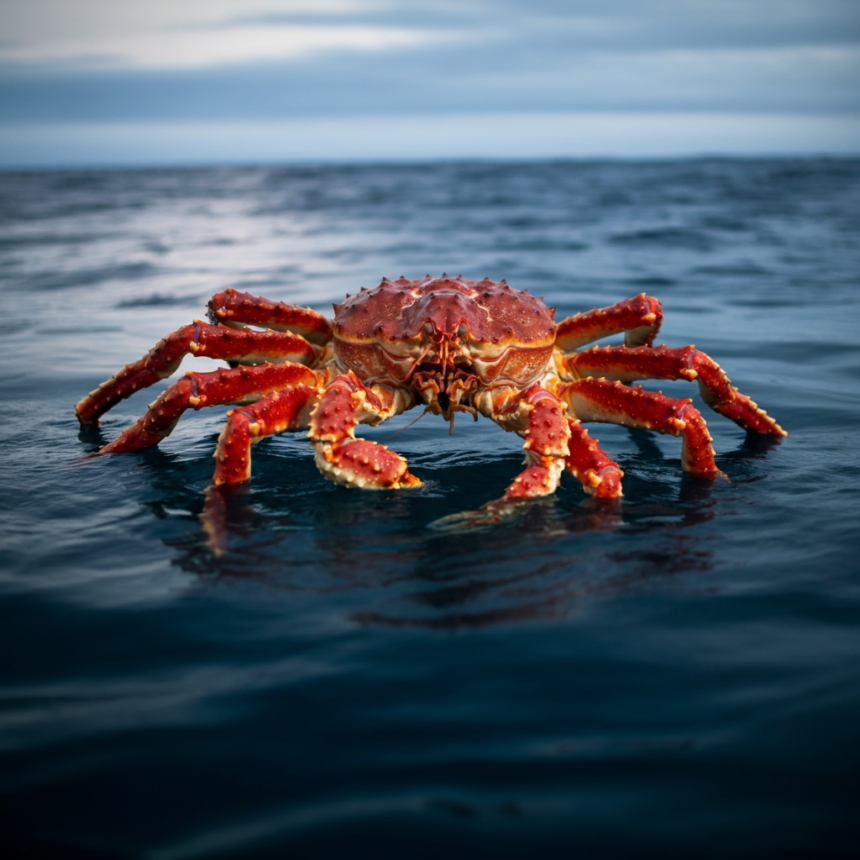Introduction to Red King Crab
Often referred to as the “king” of crabs, red king crab isn’t just a name—it’s a reputation. This crustacean is beloved for its impressive size, delectable flavor, and versatility in gourmet cuisine.
Whether you’re indulging in a luxurious seafood feast or trying your hand at preparing it at home, the red king crab consistently takes center stage on any plate. But, what makes it so special?
And why is it one of the most sought-after seafood items in the world?
This blog will explore everything you need to know about red king crab, from its fascinating habitat to its irresistible appeal, nutritional benefits, sustainability efforts, and even how to enjoy it at home.
What is Red King Crab?
The red king crab (Paralithodes camtschaticus) is no ordinary crustacean, often garnering attention for its substantial size and vibrant red hue.
Physical Description
- Size: Red king crabs are among the largest crustaceans, with adult males weighing up to 24 pounds and spanning an impressive five feet from claw to claw.
- Appearance: These crabs are characterized by their hard, spiked shells and dark reddish-brown coloration, which turns bright red when cooked.
Habitat and Life Cycle
- Habitat: Native to cold waters, red king crabs thrive in the Bering Sea, as well as along the coasts of Alaska and Russia. They prefer depths of 90 to 300 feet, depending on the season.
- Life Cycle: Starting as tiny larvae, these crabs undergo multiple molting stages before reaching adulthood, a process that can take up to seven years. Once mature, they have few natural predators besides humans and are known for their long lifespan, sometimes exceeding 20 years.
Where to Find Red King Crab
Looking to spot—or savor—red king crab? It’s no surprise that their habitats are concentrated in some of the most challenging marine environments.
- The Bering Sea is one of the most abundant regions, providing both thriving ecosystems for the crabs and a challenging battleground for fishermen.
- Alaskan Waters, particularly near Bristol Bay and Norton Sound, are celebrated for producing some of the highest-quality crabs in the world.
- Russia’s Far East also boasts rich populations of red king crab, particularly near the Kamchatka Peninsula.
Despite their wide distribution, seasonal shifts and strict fishing regulations mean that their availability can vary, often pushing demand—and prices—even higher.
The Appeal of Red King Crab

There’s a good reason why red king crab is synonymous with indulgence.
Taste and Texture
The meat of a red king crab is sweet, succulent, and tender, with a firm yet delicate texture that melts in your mouth. Its slight briny undertone evokes the pristine waters from which it’s harvested.
Culinary Uses
Red king crab is a versatile ingredient that can elevate a variety of dishes, such as:
- Crab legs dipped in warm butter for a classic, comforting dish.
- Seafood platters that celebrate its grandeur alongside shrimp and oysters.
- Crab cakes infused with herbs and spices, balancing the sweetness of the meat.
From casual dining to fine cuisine, red king crab is a true show-stopper.
How Red King Crab is Harvested
Harvesting red king crab is no easy feat—it’s a high-stakes endeavor requiring skill, patience, and an appreciation of the sea’s unpredictable temperament.
The Process
- Catching Methods: Fishermen use large, baited pots (traps) placed strategically on the ocean floor to lure these bottom-dwelling crustaceans.
- Season: Harvesting typically occurs during winter months when crabs migrate to shallower waters, albeit facing harsh, icy weather conditions.
Regulations and Challenges
The fishing industry enforces strict quotas to ensure populations remain sustainable. Overfishing is a constant concern, making government oversight and responsible practices essential.
Nutritional Benefits
Beyond its exquisite taste, red king crab is a powerhouse of nutrition.
- High Protein Content: A serving of red king crab provides a substantial dose of lean protein, perfect for muscle repair and overall health.
- Rich in Vitamins & Minerals:
-
- Zinc, which supports immune function.
- Selenium, an antioxidant that protects against cell damage.
- Vitamin B12, essential for energy production and brain health.
- Low in Fat & Calories: Despite its rich flavor, red king crab is low in both fat and calories, making it an ideal choice for health-conscious seafood lovers.
Recipes and Cooking Tips
If you’re ready to prepare red-king crab at home, here are some tried-and-true recipes to get started.
Recipe 1: Classic Steamed Crab Legs
- Ingredients:
-
- Red king crab legs
- Melted butter (optional)
- Instructions:
-
- Steam the legs over boiling water for 5 to 7 minutes until heated.
- Serve immediately with melted butter for dipping.
Recipe 2: Garlic Butter Crab
- Ingredients:
-
- 2 pounds red-king crab meat
- 4 cloves garlic (minced)
- 1/2 cup unsalted butter
- Instructions:
-
- Melt butter in a skillet, adding garlic and sautéing until fragrant.
- Toss in crab meat and coat evenly. Serve hot!
Cooking Tips
- Use kitchen shears to easily crack the shells.
- Avoid overcooking, as it can toughen the meat.
Sustainability Concerns
Like many prized marine species, red-king crab faces sustainability challenges, largely driven by overharvesting and climate change.
Ensuring Sustainability
- Fishing Quotas are based on population surveys, ensuring only a limited number are caught each season.
- Marine Protected Areas (MPAs) have been established in key habitats to safeguard their ecosystems.
- Consumer Efforts: Choosing sustainably sourced crab and supporting eco-friendly seafood initiatives can make a significant difference.
By being mindful of sustainability, we can enjoy red-king crab without compromising the health of our oceans.
Why Red King Crab Deserves a Spot on Your Plate
Red king crab is more than a delicacy—it’s an experience. From its unmatched flavor and nutritional benefits to its role in driving sustainable practices, it embodies the best of what the ocean has to offer.
Whether you’re enjoying it at a fine dining restaurant or steaming it at home, savoring red-king crab is always worth it. Explore your local seafood market or restaurants to immerse yourself in its luxurious taste.
FAQs
Q1. How much does red king crab cost?
Red king crab is a premium seafood item, typically costing $60–$100 per pound, depending on quality and season.
Q2. How do you know if red-king crab is fresh?
Fresh crab should have a slightly sweet aroma, bright red color, and firm texture when cooked.
Q3. Are there any substitutes for red-king crab?
If unavailable, snow crab or Dungeness crab can provide similar but less luxurious flavor profiles.
Q4. Is red-king crab safe for those with shellfish allergies?
No, it is not safe. Those allergic to shellfish should avoid all crustaceans, including red-king crab.
Q5. Can red king crab be refrozen?
It’s best to consume crab meat fresh or shortly after thawing to preserve its flavor and texture.





